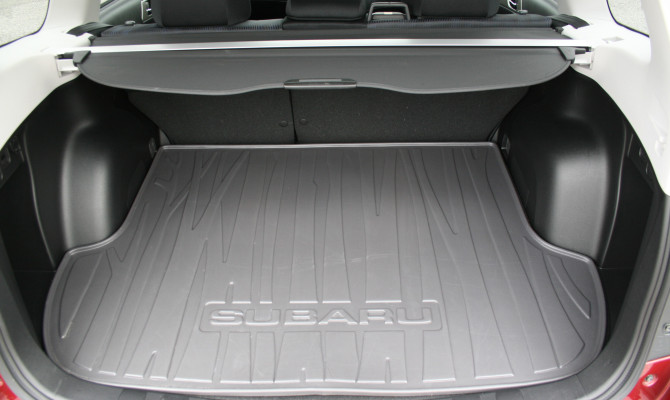The reliable Subaru Forester is a very impressive blend of utility, comfort, handling and fuel efficiency in a compact package…








A redesigned third-generation Subaru Forester was an early 2009 model year release.
A new look, better performance, enhanced safety features and more interior space were all achieved without drastic changes to the exterior dimensions of this popular compact utility vehicle.
A “Boxer” type engine, with horizontally opposed cylinders (like a Porsche engine), and a symmetrical all-wheel-drive system distinguish a Subaru, as a Subaru. Forester has an excellent history of mechanical dependability and the Subaru essentials are packaged with a practical, utilitarian body.
Compared to the previous generation Forester, the ’09 came with a new chassis with a wider track and a longer wheelbase (by 9 cm), plus a new double wishbone rear suspension. The structural changes also yielded extra cargo space and more rear passenger head and legroom.
The single overhead camshaft base engine can produce 170-horsepower and fuel economy is rated at 10.6/7.5 L/100 km (city/highway). While reliable, it’s no rocket and flat-out acceleration to 100 km/hour takes more than 10 seconds. Agile handling does help compensate for tame straight-line speed.
A turbocharged variant has twin-camshafts and can produce 224-horsepower. However, it likes premium fuel and consumes 10.9/8.3 L/100 km (city/highway). Manual transmission models have an electronic “hill holder” feature. When stopped on an incline this feature delays release of the foot brake to prevent the vehicle from rolling backward and gives the driver more time to achieve a smooth take-off. The automatic option was a conventional four-speed.
Forester got top marks from the Insurance Institute for Highway Safety (IIHS) in its rollover test. The roof is more than double the strength required by U.S. federal safety standards.
In addition to all-wheel-drive system, a Forester comes with anti-lock brakes and an electronic stability control system called Vehicle Dynamics Control. It also provides what Subaru describes as a ‘virtual’ limited slip rear differential function.
The 2009 Forester was offered in four trim levels; 2.5X, 2.5X Touring Package, 2.5X Limited and a 2.5XT Limited model with a turbocharged engine. Even a base Forester 2.5X comes well equipped with heated seats, air conditioning, power windows and mirrors, roof rails, a tilt and telescoping steering wheel with audio controls.
A new PZEV (partial-zero-emissions-vehicle) edition of Forester was added for the 2010 model year. Emissions are about 90 per cent lower than most (2010) vehicles, according to Subaru.
In 2011, the base 2.5-litre boxer engine got a double overhead camshaft upgrade, plus new bore and stroke dimensions. While maximum output remained at about the same level, more power is available at a lower rpm and fuel economy improved. Other than a new height-adjustable front passenger seat no significant changes were made in 2012.
The reliable Subaru Forester is a very impressive blend of utility, comfort, handling and fuel efficiency in a compact package. While Forester has a loyal following, Subaru’s smaller dealer network may be an issue, depending where you live, and used resale values are typically higher than average.
Price Check: 2009 – 2012 Subaru Forester (November 2013)
Year Edition Expect to Pay Today
2009 2.5X Limited $16,000 to $20,000
2010 2.5X Limited $19,000 to $23,000
2011 2.5X Limited $22,000 to $26,000
2012 2.5X Limited $25,000 to $29,000
*Prices vary depending on a used vehicle’s condition, mileage, usage and history. A reliable auto technician prior to purchase should always perform a complete mechanical check.
Recalls on the 2009 – 2012 Subaru Forester:
2009: An oil supply pipe to the engine turbocharger may crack, at the stay brazing on the cylinder head-side, and this could potentially cause an engine compartment fire. Dealers will replace a cracked pipe with a modified unit or install an additional bracket to increase the rigidity of the pipe.
2009 to 2012: A faulty centre rear seating position seatbelt retractor may not allow proper installation of a child restraint or booster seat. Subaru sent owners a locking clip with instructions on how to properly secure a child restraint or booster seat. Dealers will replace the centre seatbelt retractor upon request.
2009 to 2012: Dealer-installed accessory puddle lights may short circuit and cause the lights to melt. Dealers will install an additional fused wiring harness to protect against short circuits.
Recent Comments
- { Enjoyed your Forest of Bowland in the BMW X5M, particularly the photo of the BMW in front of the main part of Stonyhurst College where... }
- { Bantam designed the Jeep, not Willy's or Ford. The American military gave the original Bantam prototype to Willys and Ford to copy. There is plenty... }
- { All Escalades come with a 6.2-lilter V8 engine that produces 420 horsepower. A six-speed automatic is the only transmission offered and drives the rear wheels.... }
- { Alexandra is an excellent journalist. }
Popular Posts
- Journey to a ‘Sparkling’ Luxury Okanagan Resort “Four lucky readers will put a Dodge Journey’s weekend-...
- The Need For Speed: Hike Those Highway Limits More than half of those polled believe the province sho...
- Drives-U-Crazy… Erratic drivers. An early morning drive from Kelowna to Vancouver is nor...
- Readers Respond: The Pros and Cons of Increasing B.C. Speed Limits Increasing the speed limits will only increase risk to...
- Honda CR-V Review: The Compact Crossover To Get Things Done The CRV is a very stylish and aerodynamic crossover veh...






